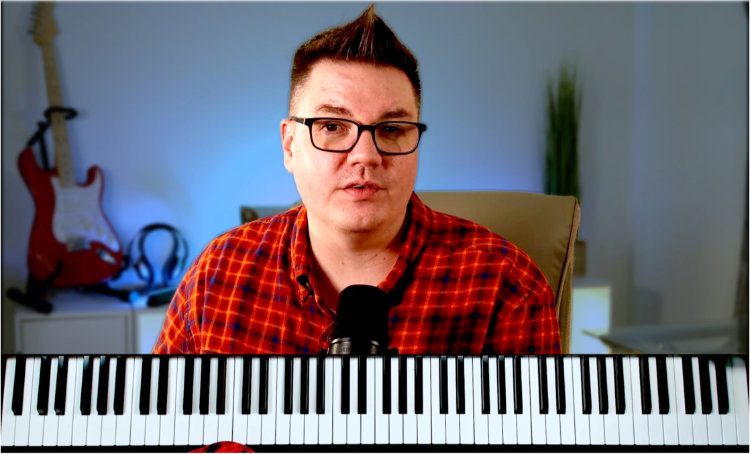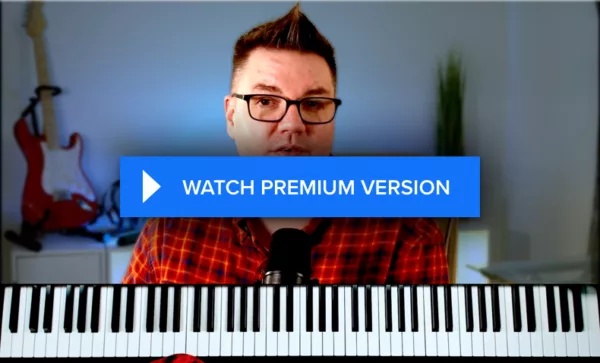We use dominant 7th chords in every jazz standard we play. It's important that we know how to form these dominant chords, as well as how to voice them in our hands so they sound musical.
So, how do we voice dominant 7th chords? A dominant 7th chord has the root, 3rd, 5th and flat-7th of the scale. One common way to voice that would be with the root and flat-7 in the left hand, the 3rd, an extension and the melody note in the right.
This article is part of my series on Foundational Chord Voicings. Make sure to check out the other relevant parts of this series on major chord voicings, and minor chord voicings.
The Notes of the Dominant 7th chord #
What is a dominant 7th chord? A Dominant 7th chord is a 4-note chord consisting of the root, 3rd, fifth and flat-7th. You can build the chord upwards from its root by stacking major-3rd, minor-3rd and minor-3rd intervals. The dominant chord has a key function in jazz, to resolve down a fifth.
You can also think of this as taking the 1, 3, 5 and flat-7 from the Mixolydian mode. There's only one dominant chord in the key, and it's primary function is to resolve you back to the I chord, as if it is taking you back home.
Secondarily, dominant chords can be used to take you out of the key, resolving you temporarily, or even permanently, in a new home.
Here's a C7 chord:

Step-by-Step Video Training
As a premium member of Jazz-Library you will have access to our Jazz Fundamentals video course which has 70+ video lessons teaching you these chords, chord voicings, comping rhythms and more.
Dominant 7th chords often come decorated and altered. In their stock voicings they come with 9th and 13ths, but jazz musicians love to alter their extensions with flat-9's, sharp-9's, sharp-11's and flat-13's. In fact, when you consider all the diatonic notes in the key, plus the available alterations, you've got your pick of any of the 12 notes of the chromatic scale. When voiced right, any note on your instrument can be part of a dominant chord.
Root Position Voicing #
In it's most basic form, the dominant chord contains 4 notes, spaced in thirds. This voicing is used all the time in the blues, and forms the foundation for fancier voicings to come.
Dominant 7th Chords in Root position: #

Dominant 7th Chord Inversions #
We can rearrange the notes of these chords by taking notes off the bottom and putting them on the top. By doing so, we can move the chord up and down the piano, which lets us keep our chord progressions close together with good voice leading.
Dominant 7th Chords in 1st Inversion: #
First inversion is created by moving one note from the bottom of the chord to the top, like this:

To make things easier to read, I've adjusted the octave of some of the notes to keep them more centered on the staff.
Dominant 7th Chords in 2nd Inversion: #
2nd Inversion chords are built similarly, but instead of moving just one note from the bottom, we move two.

Dominant 7th Chords in 3rd Inversion: #
3rd Inversion move three notes from the bottom to the top.

3-Note Voicings #
Dominant chords are decorated full of color tones, and in order to make space for those extra notes, we need to first reduce these to a simpler set of basic chords to work from. 3-note voicings are a way of playing dominant chords more simply. While this concept applies to major and minor chords as well, it's especially important in dominant chords so we don't run out of fingers when we start adding more notes.
These 3-note voicings have only the root, the 3rd and the 7th, with the 5th removed. The 5th has such similar overtones to the root, that we can leave it out and hardly even notice.
The sound of the dominant chord really comes from the 3rd and flat-7th, which form a tritone interval. This tritone is unstable, and makes the chord feel the need to resolve.
The tritone is also the exact middle of an octave, so even if you flip the order of the 3rd and 7th, the interval stays the same. The voicing with the 3rd on the bottom of your right hand is called the A-Voicing, and the 7th on the bottom is called the B-Voicing. You'll want to master both.
A-Voicings #
In the A-voicing, the 3rd is on the bottom of your right hand.
Here's a C7 chord as an example:
B-Voicings #
Here's the C7 chord in A-voicing, with the 7th on the bottom of your right hand.
Rootless Voicings #
Rootless voicings are where dominant chords start to really come to life. As the name implies, we take the root note out of the chord, but we also add the 9th and the 13th. This creates an incredibly pleasing sound, full of interesting colorful notes.
The dominant 7th rootless voicing contains the 3, 7, 9 and 13. (whoa!). Just these 4 notes span almost 2 octaves when stacked in that order. To make them playable with one hand, we'll have to arrange them in a more compact order.
Below are the two standard approaches for dominant 7th rootless voicings. You should learn them in both hands.
A-Voicings #
The A-voicing is structured with the 3 on the bottom, as 3-13-7-9.
B-Voicings #
The B-voicing has the same notes, rearranged with the 7th on the bottom, 7-9-3-13.
Spread Voicings #
There are many different approaches to arranging these four notes spread across both hands. Doing so gives you the freedom to bring the root or the 5th back in the chord too, as the chord lays out across a wider range of the piano (plus, you have more fingers). Try laying them out in different ways yourself and see what kinds of sounds you can achieve.
Here are a couple examples to get you started:
Altering Dominant 7th Chords with Color Tones #
In it's basic rootless voicing arrangement, the dominant 7th chord is already quite colorful. But, we can take things even further. The 9th and 13th in the voicing can be swapped out for altered versions of those same notes.
For each of the variations below, I've demonstrated the C-dominant 7th chord based on a rootless voicing in the right hand, with the root played an octave lower in the bass. This helps you fully hear the unique altered sound of each chord.
A common question I hear is: when is it appropriate to play these altered voicings? The answer is, most simply, whenever it sounds pleasing to you. There are times when you decide to use alterations based on logic, when the altered note is the melody note, for example. But, don't get too bogged down by trying to reason your way into one voicing or another. Music is a hearing art, if it sounds good, use it.
Dominant Seven Flat-Nine #
The first alteration I learned when experimenting with dominant chords was changing the 9th to a flat-9th. When used in a V-I, or V-i cadence, the flat-9 creates a nice chromatic leading tone back to the root of the tonic chord.
(Extra credit: This note works really well in minor because it's part of the Phrygian mode.)
Dominant Seven Flat-Thirteen #
Here's an alteration substituting the 13th for a flat-13th.
Note: As you work your way through tunes, you might also find a sharp-5 chord. Perceptive jazz students will recognize that the flat-13 and sharp-5 are the same note. (In C, sharp-5 would be G#, and flat-13 would be Ab, which are enharmonically the same.) In this case, a flat-13 implies that the natural fifth is still in the chord, where a sharp-5 implies that the fifth is changed to the sharp-5.
Combining Flat-Nine and Flat-13 #
The flat 9 and flat 13 are great individually, but they can be combined as well:
Dominant Seven Sharp-Nine #
Similar to the flat-9 voicing, you can also swap the nine for the sharp-9. This is one of the edgiest chords in traditional jazz, as the sharp-9 and 3 create a minor-second interval that is dissonant. That interval sounds so bad, but in a way that is oh so good in the context of a tune. Music is about exploring dissonance resolving to consonance, and this sharp-9 chord creates so much tension that its resolution is extra gratifying.
The "Altered" Chord #
If you see a chord symbol like C7alt, it means you can use any of the above alterations following your own taste. That said, many jazz musicians standardize on the altered sound to mean the combination of the sharp-9 and the flat-13.
Dominant Seven Sharp-Eleven #
We've talked mostly about alterations to 9ths and 13ths, but the sharp-11 is used quite often as well. It's one of the least dissonant alterations, and it adds a really nice lush color to the chord.
Below I've voiced the C7#11 chord using an upper structure voicing. That is, I played a 3 note C7 in my left hand, and a Dmajor triad in the right. This is a shortcut to playing a natural-9, sharp-11, and natural-13.
Fourth Voicings #
Modern jazz musicians like to think of their chords by stacking 4ths instead of 3rds. It creates a wider, thicker sound, and gives each note more color without creating tons of dissonance. For dominant chords, fourth voicings are hip and provide tones of options for voice leading.
There are lots of options for voicing in 4th, especially as you consider all the extended options. Below are two standard voicings for unaltered dominant chords. I've included the root to help you hear the full chord, even though you may leave it out in your playing.
A-Voicing #
The A-voicing has four notes in the following order: 3-7-9-5.
Note that we use the 5 instead of the 13, to keep the fourth intervals intact.
B-Voicing #
The B-voicing keeps the 13th in the chord, and arranges the notes with the 7th on the bottom: 7-3-13-9
Practice Tips #
In order to use these voicings in songs and improvisation, you'll have to internalize them. Here are some exercises I use to get comfortable:
- Play them through the circle of 5ths, counter-clockwise and clockwise.
- Play them chromatically
- Play them in diatonic scales
- Use flash cards to drill them randomly.
Play all four of those techniques with the chords in your right hand, then in your left, and then both hands together.
